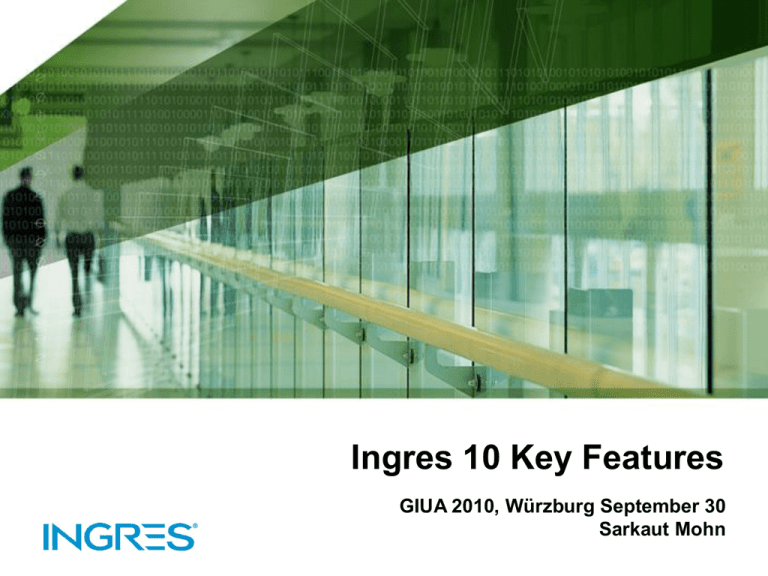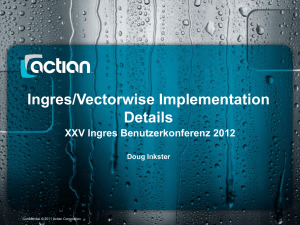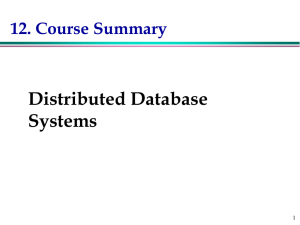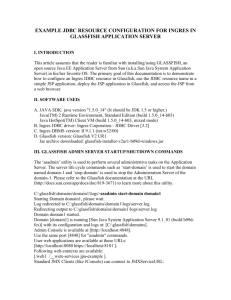Ingres 10 DBMS
advertisement

Ingres 10 Key Features GIUA 2010, Würzburg September 30 Sarkaut Mohn Ingres 10 Key Features New Ingres 10 Features Derived by Ingres ISV Partners – – – – – – – Multi Version Concurrency Control (MVCC) Scalar Subqueries Batch Query Execution Data Encryption Rename Objects Long Identifiers Bulk Load Performance Confidential — © 2010 Ingres Corporation Slide 2 MVCC Why We Need It? Time Update Transaction Read Transaction with Traditional Locking Read Transaction with MVCC Locking • Updates row A in table X • Attempts to read row A in table X • Updates row B in table Y BLOCKED because read cannot acquire lock held by update! • Commits transaction • Read from table X finally succeeds after update has committed With MVCC, readers are no longer blocked by writers Likewise, writers are no longer blocked by readers Confidential — © 2010 Ingres Corporation Slide 3 • Successfully reads row A from table X • Successfully reads row B from table Y Data read is preupdate, so no locking required No application hangs Better performance! MVCC Why We Need It? Existing applications originally written for DBMSs like Oracle that support MVCC depend on the high concurrency it provides Avoids performance problems and application hangs that Ingres encounters with traditional (ANSI Isolation Level based) locking Applications can avoid having to read inconsistent data – Ugly workaround of running with dirty read isolation will no longer be necessary Readers see consitent transaction / statement snapshot of data based on isolation level Confidential — © 2010 Ingres Corporation Slide 4 Scalar Subqueries Ingres currently only allows scalar subqueries to be used in limited contexts SELECT * FROM t1 WHERE t1.col = (SELECT min(col) from t2 where t2.key = t1.key); DELETE FROM t WHERE col = (SELECT max(col) FROM t); Ingres 10 will allow scalar subqueries to be used in more instances Rewriting existing applications to avoid subqueries is not easily scriptable Confidential — © 2010 Ingres Corporation Slide 5 Scalar Subqueries Examples Usage Example Projection List of SELECT SELECT emp_name, dept_name, (SELECT MAX(salary) FROM emp) AS highest_salary FROM emp; VALUES clause in INSERT INSERT INTO credit(name, max_credit) VALUES(‘XYZ’, (SELECT MAX(credit) FROM credit_table WHERE name = ‘XYZ’)); SET clause in UPDATE UPDATE tab1 t1 SET col = (SELECT sum(col) FROM tab2 t2 WHERE t2.key = t1.key); CASE expression SELECT vars, CASE (SELECT expr FROM t2 WHERE t2.key = t1.key) WHEN 1 THEN ‘A’ ELSE ‘B’ END FROM t1; Procedure parameter EXECUTE PROCEDURE proc (count_param = (SELECT count(*) FROM t)); Confidential — © 2010 Ingres Corporation Slide 6 Batch Query Execution Non-Batch Execution Client Application Batch Execution Ingres DBMS JDBC Application Creates Table Create Table Inserts into Table ok ok ok ok Executes Procedure Execute Procedure Creates Table Inserts into Table Executes Procedure Create Table Insert into Table Execute Procedure ok Insert into Table Ingres 10 DBMS ok Any SQL statement can appear in a batch, except: – – – Fewer round trip messages Better performance! SELECTs Row producing procedures Transaction Statements Individual statements in the batch can succeed while others can fail, provided the failures aren’t severe Confidential — © 2010 Ingres Corporation Slide 7 Batch Query Execution Current Supported Interfaces Java – Use addBatch and executeBatch methods – Unchanged from previous releases • But now recognized by the DBMS rather than translated in JDBC • Massive improvement in performance OpenAPI – New IIapi_batch() function No other interfaces currently supported – ODBC may come soon Confidential — © 2010 Ingres Corporation Slide 8 Batch Query Execution Additional Feature Details Ingres JDBC driver already supports the API interfaces necessary for batch execution – addBatch – executeBatch Existing JDBC implementation, however, executes the same as non-batch; i.e., no reduction in client-server communication Batch execution also allows a single statement to be executed with multiple sets of parameters This form of execution has been optimized for better load performance Performance of ETL tools that use batch execution in this way will therefore benefit Confidential — © 2010 Ingres Corporation Slide 9 Batch Query Execution Special Optimization for Insert Ingres 10 DBMS JDBC Application • Prepare INSERT statement •Execute “prepare” ok • Add “Execute INSERT with parameter set 1” to batch • Add parameter set 2 to batch •… • Add parameter set n to batch • Execute batch •Load “copy” buffer with each parameter set •Execute Copy Statement to insert data •Return results ok … ok Confidential — © 2010 Ingres Corporation Slide 10 Batch Query Execution Related Parameters JDBC – System Property: ingres.jdbc.batch.enabled • Determines whether executeBatch() will translate into batch execution in the DBMS or revert to the pre-10.0 behavior DBMS – Config Value: ii.<node>.*.batch_copy_optim • Values “ON” (use the copy optimization), “OFF” (do not use the copy optimization, insert statements are not converted to a copy) – SQL “SET [NO]BATCH_COPY_OPTIM” • As above for current session only All parameters are for debug purposes only Confidential — © 2010 Ingres Corporation Slide 11 Data Encryption Required for – PCI-DSS 1.2 compliance - credit card information storage (https://www.pcisecuritystandards.org/) – HIPAA compliance - health information storage Applies only to data “at rest” Specified at the column level By default, a “salt” and “verification hash” will be embedded in the encrypted data – Salt – Random bits that further obfuscate the encrypted data – Verification hash – Collision-resistant hash that allows the integrity of the decryption to be verified Confidential — © 2010 Ingres Corporation Slide 12 Data Encryption Securing the Encryption Keys Tables with encrypted columns must specify: – Whether to use AES-128, AES-192, or AES-256 encryption – An encryption passphrase Passphrase is never stored on disk, only the encrypted table key Random Key AES-256 Encryption Encrypted Encrypted Table Key Key Table To access encrypted columns within a table, encryption passphrase associated with the table must be enabled at server startup Encrypted Encrypted TableKey Key Table Key Derived From Passphrase Key Derived From Passphrase Unencrypted Table Key AES-256 Decryption Unencrypted table key can then be used to encrypt/decrypt column data Confidential — © 2010 Ingres Corporation Slide 13 Rename Objects Introduction Rename table/column: Ability to rename a table or a column using new SQL syntax: No need to drop and recreate the table. No need to drop and add the column. No unload/reload of data. Rename Objects New SQL Syntax Table rename [EXEC SQL] RENAME [TABLE] [schema.]<table_name> TO <new_table_name> [EXEC SQL] ALTER TABLE [schema.]<table_name> RENAME TO <new_table_name> Column rename [EXEC SQL] ALTER TABLE [schema.]<table_name> RENAME [COLUMN] <column_name> TO <new_column_name> Rename Objects Access Restrictions You must own the tables (or whose column) you are renaming. You cannot rename a system catalog, extended system catalog or any tables owned by super user ‘$ingres’. You cannot rename columns of such catalogs Rename Objects Naming Restrictions The name of the new table/column should conform to naming rules for tables. – See SQL Reference Guide, chapter 2. There should be no table / column already existing in the database with same name and owner – The new table / column name will get the same reltid or attribute id. Long Identifiers Ingres object names are currently limited to 32 characters Current limit is problematic for applications like Hibernate that auto-generate long names Ingres 10 increases most object names to 256 characters – Objects affected include: tables, columns, procedures, parameters, rules, sequences – Objects excluded include: databases, users Enhancements made in DBMS to avoid additional memory overhead if applications do not need long identifiers Pre-existing databases will be converted to support long identifiers during database upgrade Confidential — © 2010 Ingres Corporation Slide 18 Bulk Load Performance CSV (comma separated values) and SSV (semi-colon separated values) delimiters allow COPY to READ / WRITE files COPY from text file up to 2x faster COPY FROM loading partitioned table bulk loads into partitions Confidential — © 2010 Ingres Corporation Slide 19 Other Ingres 10 Features Application Enablement Features – New BOOLEAN Data Type (TRUE, FALSE, NULL) – JDBC 4.0 Compliance Additional remote data access performance improvements New Functions – GREATEST, LEAST, NVL, NVL2 Hash Join and Hash Aggregation Improvements Recovery Server Error Handling Ingres for 64-bit Windows 64-bit ODBC Driver Confidential — © 2010 Ingres Corporation Slide 20 Full Ingres 10 Features http://community.ingres.com/wiki/Ingres_Roadmap/10 Confidential — © 2010 Ingres Corporation Slide 21 Potential Features Post Ingres 10 Scrollable Cursors for Large Objects UTF-8 Transliteration Reuse Indexes for Constraints Allow NULLs in Unique Columns Expanded Usernames Stored Procedure Enhancements ALTER TABLE Enhancements Implicit Commits for DDL … Improved Data Partitioning Query Caching Improvements Improved Memory Management Improved Top N Performance Improved Performance Monitoring Generate data histograms within the DBMS Improved UTF-8 Performance Installer Enhancements Improved GeoSpatial Support Confidential — © 2010 Ingres Corporation Slide 22










